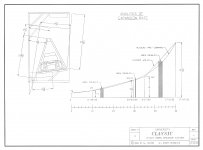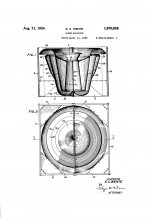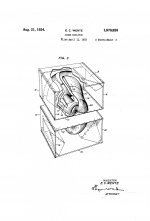Yep, in the 60s Wharfedale's top of the line loudspeaker systems, the SFB/3, Airedale and the Omni-Directional 3-way corner speaker, featured sand filled baffles.




The sand filled baffle reference got me wondering about a granite baffle. Now days you might be able to have them fabricated by a counter top shop. Would look pretty sharp too.
BLHs over a portion of their BW, normally only up to the driver's mass corner to counter baffle step loss, then TL for lower BW, or as I like to call them, big vent reflexes [BVR].
GM
GM
It's more like 14 lbs per square foot for 1" 6061.
Yah, sorry.......i’m a dumb***!
I followed the line over of the chart and failed to see I was looking @ 5” not 1”
Should be 14.112 lbs
Much more inline with reality 😱
was wondering how to tell if my cabinets were adequately braced and heavy enough and found this quoteIt's about increasing stiffness, mass loading, to provide a stable, inert working platform for the driver while not being excited by it, but when I 'ran the numbers' decades ago it wasn't heavy enough to either push the cab's resonance below it's tuning or stiff enough to raise it well above it, so while certainly an above average performer, wasn't all it could be and why I prefer pushing the cab's resonance ~ an octave above the drivers pass band with high MOE materials, proper bracing.
GM
FWIW, my test is it's enough when I can stand an old silver quarter on edge and it doesn't move when the speaker's driven with pure tones and pink noise as hard as it can handle from slightly below Fs to the XO point
Like this?
Nice, I was thinking just the baffle but the black stone enclosure looks great. Not sure how practical a 3way tower would be weight wise. Perhaps smaller 2ways could justify that for most people, that don't have access to a forklift 🙂
my design philosophy changed when my back went out. Damping and driver isolation vs mass. Can it work? I know I've been at least partially successful.
BLHs over a portion of their BW, normally only up to the driver's mass corner to counter baffle step loss, then TL for lower BW, or as I like to call them, big vent reflexes [BVR].
GM
😉
"A properly sized and designed exponential horn, a consistent design, is a non-resonant or in other words a highly damped acoustic enclosure. Without the full damping supplied by the mouth, compromised exponential horns exhibit weak quarter wavelength standing waves similar to a transmission line enclosure. This counters one prevailing myth about standing waves in horns; there are no half wavelength standing wave resonances associated with a horn geometry. All longitudinal standing wave resonances in transmission lines and compromised horn geometries exhibit quarter wavelength pressure and velocity distributions."
IOW, once you've optimized the TL's geometry (without stuffing) in such a way it no longer exhibits standing waves, you basically end up with a BLH.
Last edited:
TLs are (notorioursly) difficult to get right. I am sure GM knows how to do it.
Some years ago, I posted background info on Irving M. Fried, IMF and (Soni)kit in the "Classic Monitor designs" thread.
My own experiences with TLs are limited to TDL and PMC speakers, and honestly, I have never been too fond of the (mid)bass performance of those.
Some years ago, I posted background info on Irving M. Fried, IMF and (Soni)kit in the "Classic Monitor designs" thread.
My own experiences with TLs are limited to TDL and PMC speakers, and honestly, I have never been too fond of the (mid)bass performance of those.
Last edited:
Not in order to discourage anybody to build a TL, but it's probably wise to thoroughly investigate the 'concept' first.
Lynn Olsen's Ariel project is an example of the complexity involved.
It starts with: "A Brief History of the Ariel. Or, The Neverending Story".
And the final part:
"The actual production version is the Mark 6. This version is acoustically streamlined and optimized for automated NC-controlled woodcutting machinery. Note that the drawing omits the usual filling and wool pads shown in the other versions; this was done as a convenience for converting the drawing to a 3D DXF file. If you want to build the Mark 6 for yourself, add in the filling and wool damping pads shown in the other versions of the speaker. Although very difficult for a home constructor, this version should have the highest performance due to the gradual and progressive changes of cross-section profile in the transmission line. The goal with successive versions is a smooth approximation of a reverse-horn profile that transitions to a labyrinth at the far end.
I admit no less than six versions of the Ariel might seem intimidating at first, and probably a little annoying to those of you who are in the middle of project. In practice, though, most of this is ancient history. There are no reasons to build an early versions ... the ABC'ers report better results with each successive version. For those of you in mid-project, should you abandon what you have and switch to the latest version? I can't answer that. It's the same as whether or not you should upgrade your computer now, or wait next year. The improvements are noticeable, especially in the midbass, but the essential character of the Ariel has been there since the Mark 2. The improvements have all been in the direction of greater transparency, reduction of coloration, and optimizing the 100 to 500Hz region, which has always been the greatest challenge for any transmission-line speaker. Once you hear the TL sound, though, it's not easy to go back to closed or vented-box designs."
Ariel Mk2-Mk6c:








Lynn Olsen's Ariel project is an example of the complexity involved.
It starts with: "A Brief History of the Ariel. Or, The Neverending Story".
And the final part:
"The actual production version is the Mark 6. This version is acoustically streamlined and optimized for automated NC-controlled woodcutting machinery. Note that the drawing omits the usual filling and wool pads shown in the other versions; this was done as a convenience for converting the drawing to a 3D DXF file. If you want to build the Mark 6 for yourself, add in the filling and wool damping pads shown in the other versions of the speaker. Although very difficult for a home constructor, this version should have the highest performance due to the gradual and progressive changes of cross-section profile in the transmission line. The goal with successive versions is a smooth approximation of a reverse-horn profile that transitions to a labyrinth at the far end.
I admit no less than six versions of the Ariel might seem intimidating at first, and probably a little annoying to those of you who are in the middle of project. In practice, though, most of this is ancient history. There are no reasons to build an early versions ... the ABC'ers report better results with each successive version. For those of you in mid-project, should you abandon what you have and switch to the latest version? I can't answer that. It's the same as whether or not you should upgrade your computer now, or wait next year. The improvements are noticeable, especially in the midbass, but the essential character of the Ariel has been there since the Mark 2. The improvements have all been in the direction of greater transparency, reduction of coloration, and optimizing the 100 to 500Hz region, which has always been the greatest challenge for any transmission-line speaker. Once you hear the TL sound, though, it's not easy to go back to closed or vented-box designs."
Ariel Mk2-Mk6c:








My own experiences with TLs are limited to TDL and PMC speakers, and honestly, I have never been too fond of the (mid)bass performance of those.
I heard Pmc bb5xbd and liked the low end but the room was big and from the owner mouth they were difficult to locate correctly.
Last edited:
I heard Pmc bb5xbd and liked the low end but the room was big and from the owner mouth they were difficult to locate correctly.
I owned the smaller monitors, free standing on Partington Dreadnoughts in a 60m² room and bi-amped with Chevin amplifiers (as used in the Sony Music studios). Still couldn't quite enjoy the mid(bass) > too much 'overhang' and lack of definition for my taste.
Just before that, I had Tannoy BR floorstanders wich lacked refinement in the mids/highs, but provided nice midbass in my (then) 120m² room.
It's a matter of preference, I guess. The best bass (for me) is produced by:
- full sized straight bass horns
- big folded horns/THs
- a low xmax 15 or 18" in a oversized BR cab with foamed ports.
- big sealed subs.
Last edited:
- Home
- Loudspeakers
- Multi-Way
- Is it possible to cover the whole spectrum, high SPL, low distortion with a 2-way?





